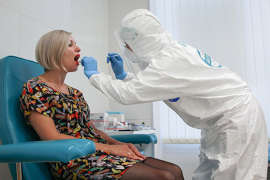
From the first days of the epidemic, covid is diagnosed by swabs from the nasopharynx – it is there that the viral particles “land”, become fixed and begin to actively multiply. But it looks like this is not the only SARS-CoV-2 incubator tank. Researchers at the University of São Paulo School of Medicine (Brazil) have published a scientific paper showing another favorite habitat and replication (reproduction) of the coronavirus. These are the human salivary glands: parotid, submandibular and small.
Scientists, using various high-tech methods, examined the tissues of such glands in patients who died from covid. Among them there were 13 women and 11 men, with an average age of about 53 years. In 75% of cases, SARS-CoV-2 was found in the samples studied.
– Ultrastructural analysis showed spherical viral particles with a size of 70-100 nm, corresponding in size and shape to the Coronaviridae family, in the cytoplasm of the duct lining, acinar cells and the lumen of the salivary gland ducts, the authors of the scientific article write.
There was also evidence of replication (multiplication) of viral particles in the cells of the salivary glands.
CONCLUSIONS OF SCIENTISTS
The salivary glands appear to be the reservoir for SARS-CoV-2, the researchers note. Two conclusions follow from this.
– Firstly, it seems that it is possible to create a highly accurate and at the same time less traumatic method for diagnosing COVID-19 (compared to deep sampling of material from the nose and oropharynx for smears).
– Secondly, new data on the multiplication of the virus in the salivary glands and the concentration of viral particles in saliva “emphasize the role of this biological fluid in the spread of the disease,” the authors of the scientific article draw attention to. This once again confirms the importance of masks and respirators worn by both sick people (to reduce the spread of infection) and healthy people (for self-protection).

